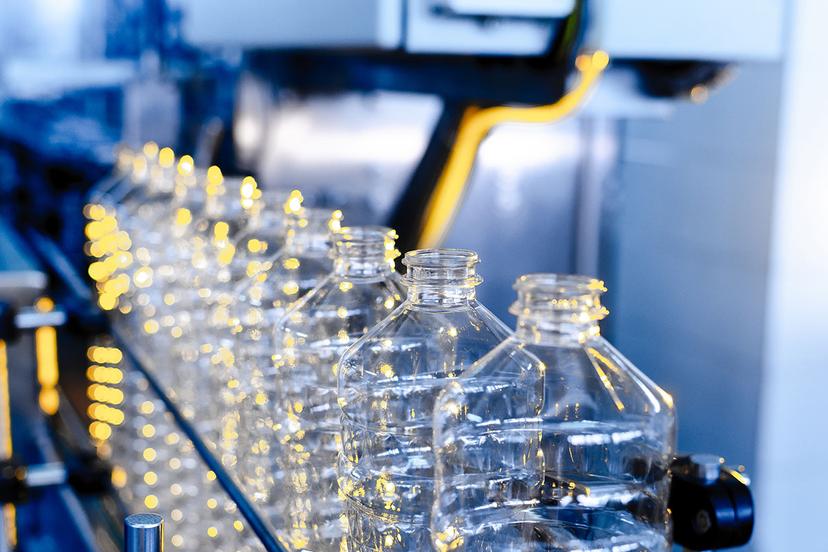Plastics

Background
Since the first synthetic plastics were produced in 1909, plastics have become a part of everyday life. Plastics can be manufactured to be hard enough to use as dies for shaping metal or soft enough to weave nylon stockings. Surgeons can use plastic screws to join broken bones; architects use plastics that resemble marble, wood, and stone; NASA scientists use plastic nose cones; and others store certain chemicals in plastic containers. Plastics companies in the United States include material makers who make the resins, processors who shape the resins, and fabricators who make end products. Plastics are supplied to almost every type of manufacturer in the country.
Because of the diversity of plastics, many of their uses go unrecognized. Most consumers are aware of plastics used in housewares, toys, electrical fixtures, toothbrushes, packages, and household detergent bottles, but they may not be aware that the lifelines of all communications—television, radio, telephone, radar, sonar, and satellites—rely on plastics for insulation and other vital components.
Given the prominent role that plastics play in modern life, it is surprising that a little more than a century ago commercial plastic did not exist in the United States. The U.S. plastics industry officially began in 1868, when John Wesley Hyatt mixed pyroxylin, made from cotton and nitric acid, with camphor to create an entirely different and new product he called celluloid. Hyatt developed the plastic in response to a competition sponsored by a manufacturer of billiard balls. Faced with a shortage of ivory, from which billiard balls were made, the manufacturer sought a product to use in its place. This was the first commercial plastic in the United States. Other forms of plastic had been developed in England a few years earlier, but they were of poorer quality.
Celluloid quickly found new uses and moved into new markets. Such products as combs, curtains, and carriage windshields were made from celluloid. The photographic film used by George Eastman to produce the first motion-picture film in 1882 was made of celluloid. Being highly flammable, celluloid was not a perfect material, spurring further development of plastics. Celluoid, however, is still in use today (under its chemical name of cellulose nitrate) for making products such as eyeglass frames.
Forty-one years passed before the plastics industry took its next major step. In 1909, Dr. Leo Hendrik Baekeland introduced phenoformaldehyde plastics, more popularly known as phenolids, the first plastics to achieve worldwide acceptance. His new substance, called Bakelite, was intended as a resin. The versatility of Bakelite soon led to the production of many products, such as cookware handles, telephones, and other parts for electrical equipment.
In the 1920s, scientists introduced polyvinyl chloride, which eventually became the second-largest selling plastic for such applications as flooring and wire and cable insulation. Another plastic, cellulose acetate, was commonly used as a waterproof varnish for the fabric of airplane wing coverings. In 1935, the U.S. firm E. I. DuPont de Nemours & Company developed superpolyamide, otherwise known as nylon. This product is still widely used today.
During World War II, there was a shortage of natural materials, which encouraged chemists and chemical companies to develop even more types of plastic. The 1930s and 1940s saw the initial commercial development of many of today's major thermoplastics: low density polyethylene, polystyrene, and polymethyl methacrylate. These plastics were primarily used in packaging consumer goods.
The increasing demand for plastics in the 1950s and 1960s led to more and more types of plastic. Some of the more important inventions of the 1960s were heat-resistant plastics and ceramoplastics that have industrial uses.
In today's society, plastics are used in every aspect of American life, including dishes, toys, signs, insulation, and appliance parts. The average car contains more than 300 pounds of plastics. As automobile manufacturers continue to seek to decrease the weight of cars so that they can meet tightening gas mileage requirements, more plastic parts are being used. Plastics are even used to replace defective heart valves, sockets, joints, and other parts of the human body.
Some uses of plastics go unrecognized because they show up in combination with other materials. All paper cartons for milk, for example, have protective coatings of polyethylene, a plastic. Many metal cans have protective plastic linings. Many glass bottles have protective plastic coverings. Other plastics go unrecognized because their appearance is similar to other materials, such as plastic outerwear that looks like leather or plastic furniture with wood-grain patterns.
Still other plastics go unrecognized because they are hidden in the finished product; for example, the myriad uses of plastics for electrical insulation in refrigerators. This use of plastics has resulted in more food-storage capacity without an increase in the outside dimensions of the refrigerator. Plastic parts and coatings on some appliances increase their lifespan by 40 percent as a result of their durability and resistance to corrosion.
In the 21st century, recycling has become an important part of plastic's life cycle. Most manufacturers use recycled materials in their manufacturing process. Recycled plastics are also used to produce new products like lumber for outdoor decking, carpeting, fleece jackets, and T-shirts. Most of the U.S. population now has access to plastic bottle recycling.
